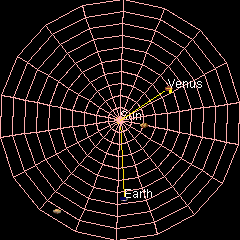Orbit of Venus
[1][2] The low eccentricity and comparatively small size of its orbit give Venus the least range in distance between perihelion and aphelion of the planets: 1.46 million km.
In Galileo’s day the prevailing model of the universe was based on the assertion by the Greek astronomer Ptolemy almost 15 centuries earlier that all celestial objects revolve around Earth (see Ptolemaic system).
Observation of the phases of Venus was inconsistent with this view but was consistent with the Polish astronomer Nicolaus Copernicus’s idea that the solar system is centered on the Sun.
[14] Observations of transits of Venus across the Sun have played a major role in the history of astronomy in the determination of a more accurate value of the astronomical unit.
An equation in Astronomical Algorithms that assumes an unperturbed elliptical orbit predicts the perihelion and aphelion times with an error of a few hours.
Formulas for computing position straight from orbital elements typically do not provide or need corrections for the effects of other planets.
[18] E. Myles Standish wrote Classical ephemerides over the past centuries have been based entirely upon optical observations: almost exclusively, meridian circle transit timings.
Venus' orbital space has been shown to have its own dust ring-cloud,[22] with a suspected origin either from Venus trailing asteroids,[23] interplanetary dust migrating in waves, or the remains of the Solar System's circumstellar disc out of which its proto-planetary disc and then itself, the Solar planetary system, formed.


